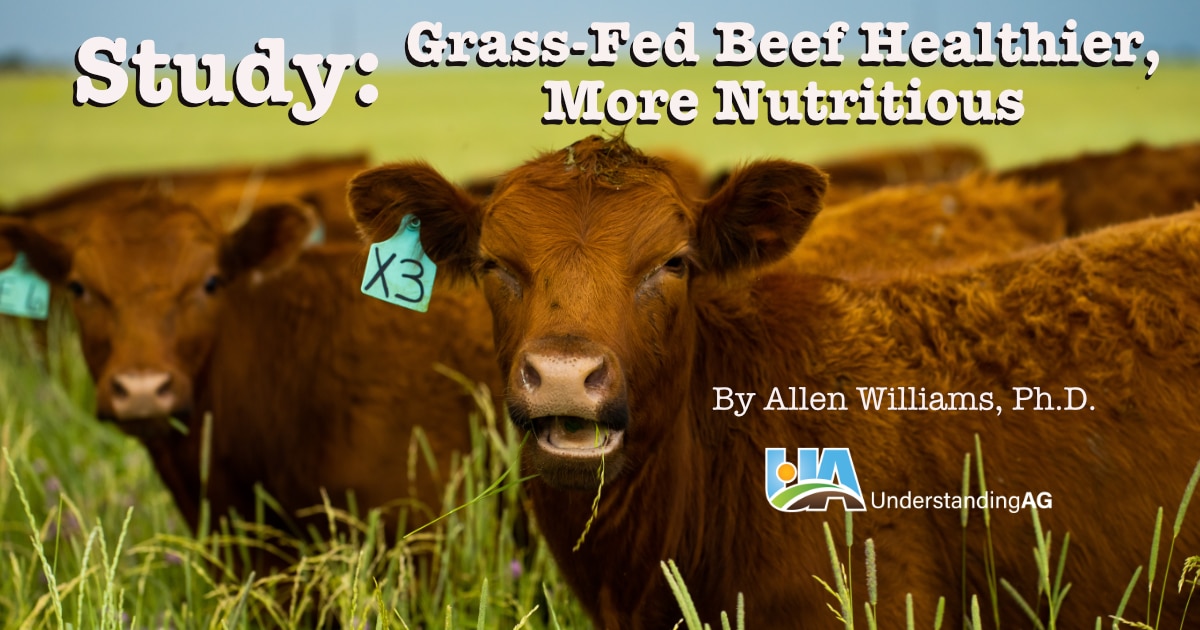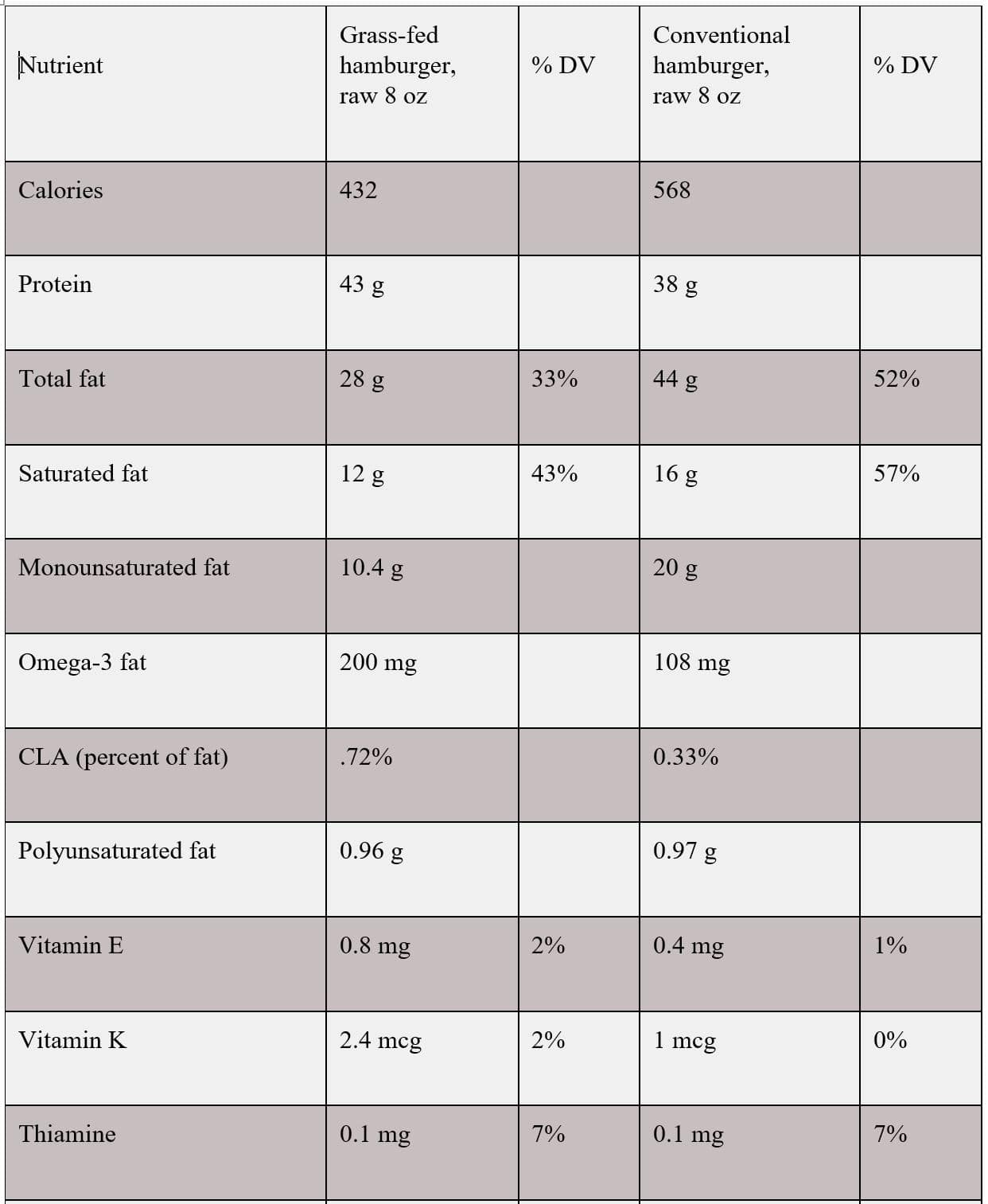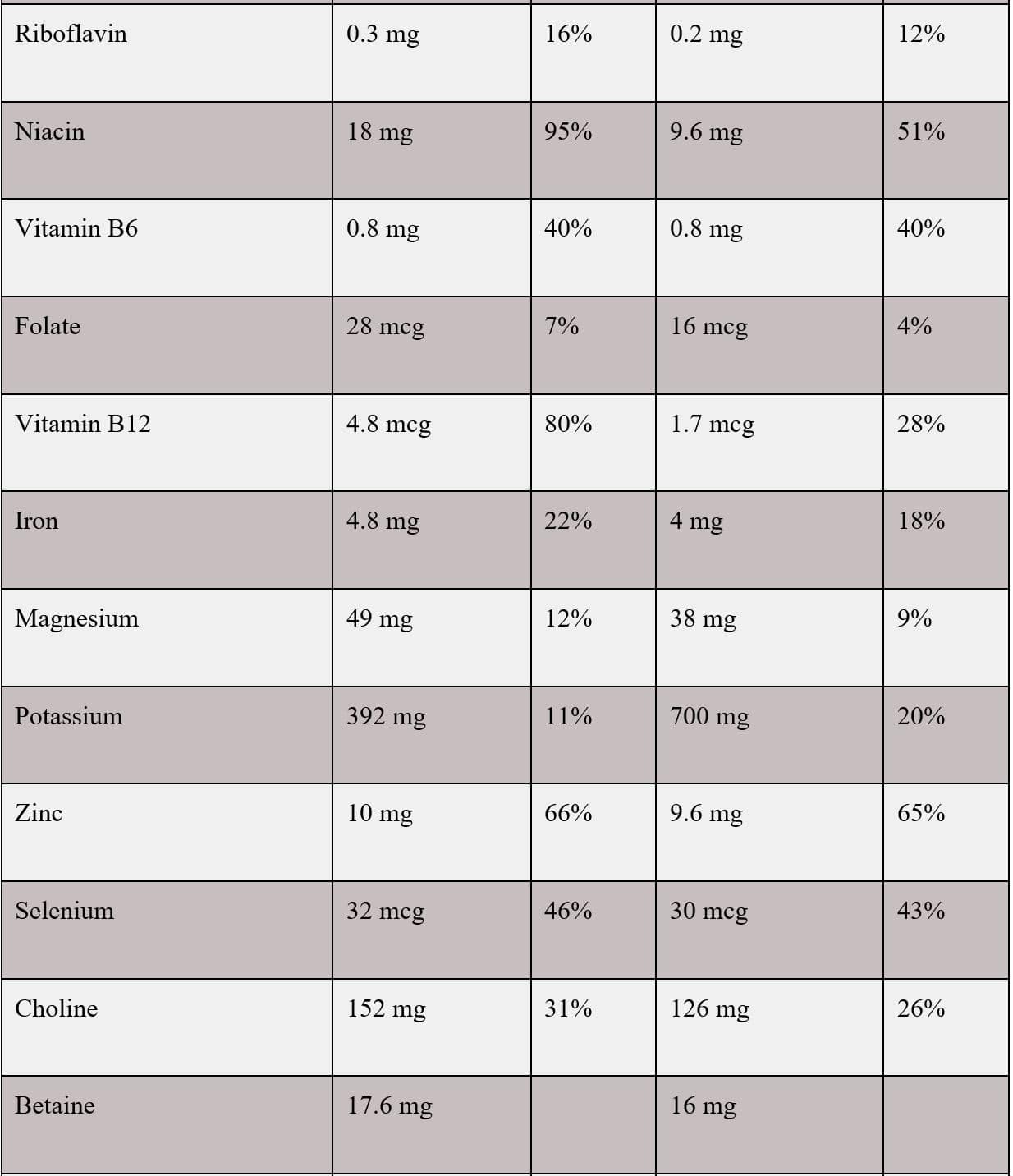
Research performed by Dr. Stephan Van Vliet, Department of Nutrition, Dietetics and Food Sciences, Utah State University, and the Bionutrient Food Association, found that grass-finishing, compared to conventional grain finishing, increases a wide variety of health-promoting compounds in meat and improves animal health. Phytochemical richness of meat is directly related to the finishing diet of animals. The research concludes that grass finishing animals concentrates significantly higher amounts of phytochemicals, including polyphenols, tocopherols, carotenoids (Beef Nutrient Density Project Report, Dec 2021).

Many studies have found that grass fed beef has higher amounts of omega-3 fatty acids, which have important roles in heart and brain health. Additionally, research has shown that grass fed beef contains higher amounts of very-long chain fatty acids, which are associated with decreased risk of heart disease.
Grass-fed animals also had lower levels of homocysteine, triglycerides, and advanced glycation end products, all of which are associated with improved cardiovascular health, both for the animal and humans.
Van Vliet found that grain-finishing negatively affects glucose metabolism, while grass-finishing improves mitochondrial/energy metabolism. In addition, the grain-fed animals had more collagen metabolites and elevated markers of protein breakdown. This compromises both animal health and meat quality. Interestingly, the muscle of grass-fed animals closely resembles the muscle structure of a healthy human athlete. In contrast, the muscle of grain-fed animals exhibits early signs of metabolic health issues. Van Vliet and co-workers conclude that this is the result of both diet and ability to exercise. Animals being grass-fed on pasture are able to move all day, while animals in a feedlot are constrained in their movement. This would be similar to comparing active to sedentary humans.
Figure 1 shows the process used for the metabolomic research conducted by Dr. Van Vliet and his team.

Phytochemical Benefits
In Van Vliet’s studies, grass-fed beef samples showed higher levels of many phytochemicals compared to grain-fed beef. There are several thousand phytochemicals in plants, and they are present in animal muscle tissue and fat as a result of diet. Phytochemicals are plant-derived bioactive compounds with important nutritional and health roles in both animal (Provenza et al., 2015) and human health (Dillard & German, 2000). Benefits of phytochemicals (Phytonutrients) include:
- Anti-inflammatory/antioxidant effects in cells
- Scavenging reactive or toxic chemicals
- Enhancing the absorption and or stability of essential nutrients
- Acting as selective growth factors for beneficial gastrointestinal bacteria
- Representing substrates for beneficial oral, gastric or intestinal bacteria
- Selectively inhibiting deleterious intestinal bacteria
Phytonutrients also play a role in preventing and managing chronic diseases, such as cancer (Choudhari et al., 2020), coronary heart disease (Ismaeel et al., 2021), diabetes (Cao et al., 2019), high blood pressure (Fraga et al., 2019), inflammation (Zhang et al., 2019), microbial, viral and parasitic infections (Yin et al., 2019), and neurological disease (Uddin et al., 2020).
Research shows that plant phenolic compounds, such as p-cresol sulfate, 4-ethylphenolsulfate, hippurate, stachydrine, and catechol-sulfate were elevated in grass-fed beef. Dietary differences significantly influence gut microbial populations in the rumen of cattle, thus influencing prevalence phytonutrient compounds. These are suppressed in grain fed animals due to the grain-based rations. These plant phenolic compounds are metabolized by the small intestine, gut microbiota and liver. They impact health and metabolism of animals and subsequently consumers of that meat.
Hippurate was almost two times higher in the grass-fed beef and is considered a strong indicator of dietary phenolic intake (Lees et al., 2013). Why is this important? Because higher levels of hippurate are associated with improved gut microbial diversity and lower odds of having metabolic syndrome in humans (Pallister et al., 2017). Catechol sulfate, a downstream metabolite of hippurate, is inversely associated with circulating cholesterol levels in humans confers anti-inflammatory effects in humans (Fang et al., 2018).
Other beneficial phytonutrients present in greater concentrations in grass fed beef include Cinnamoylglycine (cinnamic acid) and N-methylpipecolate (metabolite of coumaric acid). Cinnamic acid was 1.4 times higher in grass-finished beef compared to grain-fed beef. This phytonutrient has anti-inflammatory effects (Peperidou et al., 2017) and is linked to numerous health benefits, including reduced risk of Parkinson’s disease (Prorok et al., 2019) and cancers (Ruwizhi & Aderibigbe, 2020).
N-methylpipecolate was almost five times higher in grass-fed beef when compared to grain-fed beef. This phytonutrient reduces oxidative stress and has anti-tumor activity in colorectal cancer models (Al-Ishaq et al., 2020).
Additionally, when alfalfa was incorporated into the diets of grass-fed animals, the phytonutrients Stachydrine and homostachydrine are more highly concentrated in the meat. (Carrillo et al., 2016). Stachydrine has antioxidant properties and may have brain-protective (Li et al., 2020; Yu et al., 2018), cardio-protective (Cao et al., 2017), and anti-cancer effects (Wang et al., 2017).
Vitamin Benefits
Similar to work research performed previously (Van Vliet et al., 2021), the most recent studies found that alpha-tocopherol is three times higher in grass-fed vs grain-fed beef meat. Tocopherols are vitamin E precursors best known for their anti-oxidative effects. Similar to carotenoids, tocopherols protect against cardiovascular disease (Huang et al., 2019), certain cancers (Das Gupta & Suh, 2016; Helzlsouer et al., 2000), brain function decline (Mangialasche et al., 2012), and reduced eye-sight (Delcourt et al., 1999).
Ascorbate (vitamin C) compounds were 1.5 times higher in the grass-fed beef compared to grain-fed beef. Even though meat is not a great source of Vitamin C, higher concentrations in meat have been found to improve shelf stability and quality of the meat (Mitsumoto et al., 2006; Okayama et al., 1987).
The B Vitamins (B3, B5, B6) are typically 2-3 times higher in grass-fed beef due to the active grazing of growing forages (Duckett et al., 2009; Seck et al., 2017). However, these vitamins can be added to grain-fed rations to raise their levels in the meat. This is not necessary in grass-fed diets. Niacin (a form of Vitamin B3) was nine times higher in the grass-fed beef compared to the grain-fed beef. Niacin promotes a healthy nervous system, digestive system, and skin.
Polyunsaturated Fatty Acids
Polyunsaturated fatty acids (PUFAs) are essential to humans and cannot be made in our bodies, so we must consume these in our diets. Grass-fed meat often exhibits a better omega-6 to omega-3 ratio (usually below 3:1) and helps with reduced risk of heart disease (van Vliet et al., 2021). The omega-3 fatty acids serve as precursors for the synthesis of anti-inflammatory mediators, while omega-6 fatty acids are important precursors for pro-inflammatory lipid mediators. omega-3 fatty acids help reduce inflammation while excess amounts of omega-6 fatty acids promote inflammation.
The grass-fed beef had higher amounts two key omega-3 fatty acid metabolites, eicosapentaenoic acid (EPA) and docosahexanoic acid (DHA). The EPA was almost 10 times higher in grass-fed beef, while DHA was three times higher. Significant benefits include anti-inflammatory and antioxidant properties. They also lower the risk of heart disease, cancer, and liver diseases, along with improved brain function (Swanson et al., 2012). Additionally, linolenic acid (alpha/gamma) was 10 times higher in the grass-fed beef. This particular omega-3 fatty acid is concentrated in plants and associated with reduced risk of cardiovascular disease and important for brain health (Rajaram, 2014).
Grass-fed beef contains 2-4 times the Conjugated Linoleic Acid (CLA) compared to grain-fed beef. CLA is an essential fatty acid that has powerful anti-cancer and anti-obesity properties. For athletes, it is a critical fatty acid for the promotion of muscle gain and fat loss. Other benefits of CLA include improvement in strength, promotion of strong bones, improved growth and development, and aids in digestion.
Long-Chain Saturated Fatty Acids
Just as with the long-chain polyunsaturated fatty acids (PUFAs), long-chain saturated fatty acids were enriched in grass-fed meat. Even though saturated fat is usually considered detrimental for heart health, long-chain saturated fatty acids such arachidate, behenate, and nonadecanoate are associated with a decreased risk of diabetes and cardiovascular disease. These fatty acids were 2-3 times higher in grass-fed beef, and are considered beneficial (Lemaitre & King, 2022).
Caprate and lauric acids are saturated fatty acids that have potential antibacterial, antiviral, antifungal and anti-inflammatory properties. Caprate and laurate were 1.5 -1.7 times higher in grass-fed beef. Additionally, long-chain monounsaturated fatty acids were 2-4 times higher in the grass-fed beef. Long-chain monounsaturated fats are considered beneficial for health.
Importantly, Triacylglycerol (TAGs) were found to be lower in grass-fed meat, while long-chain acyl carnitines were higher. Lower TAGs, coupled with higher acyl carnitines, are associated with improved heart health. The risk of heart disease can also be related to the content fatty acyl glycerol and carnitine content of the meat. Fat stored in muscle tissue can serve as a major fuel for skeletal muscles at rest and during physical activity. Intramuscular fat stores also influence the palatability of meat. Within beef samples, TAG metabolites were significantly reduced in grass-fed beef compared to grain-fed samples (Figure 7) and long-chain acyl carnitines were elevated. In humans, lower TAGs (Nordestgaard & Varbo, 2014) and higher long-chain acyl carnitines (Bhupathiraju et al., 2018) are associated with improved cardiovascular health.
Diet of Animals Important for Animal and Human Health
Ruminant animal diets significantly affect their energy metabolism and glucose utilization. Grass-fed beef muscle, as compared to grain-fed beef muscle, has a higher capacity for oxidative metabolism (Apaoblaza et al., 2020). Significantly higher levels of citrate, succinate, and malate were found, resulting in higher capacity for oxidative metabolism and leading to healthier, more athletic phenotype grass-fed beef. This is very similar to findings that are made in physically active, endurance-trained humans (Kelly et al., 2020). The parallels between the findings in humans that are physically active, and physically active animals (i.e., grass-fed cattle), are striking and include increased mitochondrial metabolism and higher polyunsaturated fatty acid profiles (Kelly et al., 2020).
Additionally, homocysteine and S-adenosylhomocysteine were reduced in the grass-fed beef compared to grain-fed beef. This has positive implications for grass-fed beef relative to cardiovascular disease (Prasad, 1999). It is also further indication that the grass-fed animals were metabolically healthier than the grain-fed animals. We do know that higher homocysteine levels in humans have been associated with increased risk of heart disease (Bostom et al., 1999).
Both diet and physical activity impact muscle quality and health. Muscle quality is the result of changes in protein synthesis and breakdown (van Vliet et al., 2018a). Branched chain amino acid metabolites were significantly changed in the beef relative to diet and degree of exercise. Metabolites in these pathways appear to be significantly elevated in grass-fed animals when compared to grain-fed animals.
Finally, branched chain amino acid metabolites, especially carnitine metabolites such as isovalerylcarnitine, tiglylcarnitine, and isobutyrylcarnitine are prevalent in muscle tissue. Elevation of these amino acids is indicative of increased muscle protein content in the meat of grass-fed animals. Carnitine was higher in the grass-fed beef. Carnitine helps the body convert fat into energy. This is important for heart and brain function, muscle movement, and many other body processes. Other free amino acid metabolites were also significantly elevated only in grass-fed beef compared to grain-fed beef. The higher content of these amino acids is likely the result of increased physical activity of the grass-fed animals.
British Journal of Nutrition
A study conducted by McAfee, et.al. (2011) and published in the British Journal of Nutrition, examined concentrations of long-chain omega-3 PUFAs (LC n-3 PUFA) in humans after a randomized, double-blind study of 20 human subjects eating either a grass-fed beef diet or a grain-fed beef diet for four weeks. The subjects ate three portions of red meat weekly from a combination of beef and lamb finished on either grass or grain.
Blood samples were collected prior to start of the trial for a baseline analysis and again after the four-week dietary period. Plasma and platelet fatty acid composition, dietary intake, blood pressure, serum lipids, and lipoproteins data were collected and analyzed.
Results showed that dietary intake, plasma and platelet concentrations of LC n-3 PUFA were significantly higher in the subjects consuming the meat from grass-fed animals compared with the subjects consuming the grain-fed meats (P<0.05). The conclusion of the researchers was that red meat from grass-fed animals can be a significant contributor to dietary intake of LC n-3 PUFA in human populations.
Mark Schatzker Trials
Mark Schatzker, author of Steak, The Dorito Effect, and The End of Craving, worked with me to examine the ratio of omega-6 to omega-3 fatty acids in beef finished in grass vs grain. In particular, the objective was to look at the impact of a grain by-product feedstuff on the omega-6 to omega-3 ratio. Corn-based ethanol production produces a by-product called dried distillers’ grains (DDGs) that are routinely used in livestock rations as a cheap feedstuff.
The results of comparison between beef finished on grass and beef from feedlots using DDGs in the finishing ration were startling. The American Medical Association (AMA) states that the human diet should consist of an omega-6 to omega-3 ratio of 4-1 or less. Grass fed beef typically has an omega-6 to omega-3 ratio of 3 to 1 or less. In these trials, samples were collected and sent to a third-party laboratory for fatty acid analysis. The beef from cattle fed DDGs had omega-6 to omega-3 ratios ranging from 35-1 to a staggering 55-1.
Overall analysis
Research results indicate grass-fed beef is significantly higher in favorable fatty acids, key phytonutrients, vitamins and minerals when compared to grain-fed beef. Below is a summary of key nutritional differences between grass-fed beef and grain-fed beef.


Summary
Research results show that grass-fed beef is higher in total nutrients, phytonutrients, antioxidants, key fatty acids, vitamins, minerals, protein, and amino acids compared to grain-fed beef. These nutritional advantages make grass-fed beef a compelling nutritional option for both athletes in training and for the general population. For elite athletes, there are distinct advantages in incorporating grass-fed meats into the daily diet. Growth and recovery are significantly enhanced with the benefits of the nutritional advantages.
